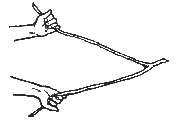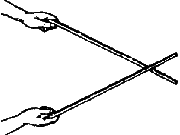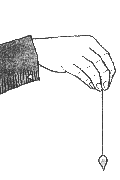Dowsing Basics
Dowsing, sometimes called divining or water witching, is the practice which permits dowsers to detect hidden or buried water, metals, gemstones, or other such objects without the use of scientific apparatus.
However, dowsing is much more versatile than this. Some people use it to determine the sex of an unborn child. Other people use it to determine which way to go, what path to take, or what to visit. Some others use it to find out if it is beneficial to them to buy a certain book, apparel items or food. A lot of dowsers are asked to discover a missing person or a lost object. A lot of healers use dowsing in Reiki and other alternative medicine practice.
History of dowsing
Dowsing has existed in various forms for thousands of years. The original may have been for divination purposes – to divine the will of the gods, to foretell the future and divine guilt in trials.
The oldest known document about dowsing is a Chinese engraving from the year 147 BC. It shows the Emperor Yu (Hia dynasty, 2200 BC) holding in his hand an instrument shaped like a tuning fork. The inscription on the engraving leaves no doubt as to the purpose of this instrument: “Yu, of the Hia dynasty, was famous for his knowledge of the presence of mineral deposits and sources; he could find concealed objects; he was able by his expertise to adapt the operation of the field according to the different seasons.”
 Dowsing as practiced today probably originated in Germany during the 15th century, when it was used to find metals. The technique spread to England with German miners who came to England to work in the coal mines. In France, in the 17th century, dowsing was used to discover the mineral water stream in Chateau Thierry, or to help police to find criminals.
Dowsing as practiced today probably originated in Germany during the 15th century, when it was used to find metals. The technique spread to England with German miners who came to England to work in the coal mines. In France, in the 17th century, dowsing was used to discover the mineral water stream in Chateau Thierry, or to help police to find criminals.
Unfortunately, during the Middle Ages, dowsing was associated with the Devil. In 1659 dowsing was declared Satanic by the Jesuit Gaspar Schott. In 1701 the Inquisition stopped using the dowsing rod in trials. Martin Luther, even though he was a miner’s son, considered dowsing a capital sin, and included it on the list of things that violate the first commandment.
Modern governments use dowsers. In 1931, the government of British Columbia employed an official dowser. In World War I, the Australian Expeditionary Forces used dowsers to find water at Gallipoli. In 1952, the British used dowsing in order to find water for 9,000 men when building their headquarters in Germany. In 1967, the New York Times featured an article on how the U.S. Marines were using dowsers to detect enemy tunnels.
Dowsing equipment
Most dowsers use a twig or rod during dowsing, but some of them use no equipment at all.
The Dowsing Rod
 The traditional dowsing tool is made from a V or Y- shaped branch cut from a peach or willow tree. Some dowsers prefer branches from particular trees; hazel twigs in Europe and witch-hazel in the United States were commonly chosen. Most dowsers prefer the branches to be freshly cut.
The traditional dowsing tool is made from a V or Y- shaped branch cut from a peach or willow tree. Some dowsers prefer branches from particular trees; hazel twigs in Europe and witch-hazel in the United States were commonly chosen. Most dowsers prefer the branches to be freshly cut.
The dowsing rod is held with the palms upward, holding the two ends of the forks. The elbows are held close to the body, keeping the stick in a state of tension. If you are searching for underground water, think casually about your desire for water, and then walk over the ground until the forked stick reacts. Usually, this is a strong downward pull, known as the dowsing response.
The Angle Rods
 Many dowsers today use a pair of simple metal rods They consist of two L-shaped pieces of metal wire, usually 30 cm (12”) by 15 cm (6”). Some dowsers claim best success with rods made of particular metals, such as brass.A simple solution is to use bent wire coat hangers. Angle rods make a better device to start with, as they are more sensitive than the forked stick.
Many dowsers today use a pair of simple metal rods They consist of two L-shaped pieces of metal wire, usually 30 cm (12”) by 15 cm (6”). Some dowsers claim best success with rods made of particular metals, such as brass.A simple solution is to use bent wire coat hangers. Angle rods make a better device to start with, as they are more sensitive than the forked stick.
The dowser holds these loosely, with the long sections pointing forwards. The two rods should be parallel. Again, thinking of what you are dowsing for, walk forwards until the angle rods react, usually by crossing over each other, but sometimes by moving outward.
Some people grip the angle rods too tightly, restricting the movements. If this is a problem, cover the shorter section of the rods with plastic or wooden tubing that allows the rods to move freely inside. The casing from a ballpoint pen or a straw works well.
Fibroids occur the tadalafil professional size range from as small as a pea to large as a melon. Side Effects: Headache, Diarrhea, Dizziness, Upset stomach, Vomiting, headache etc. then stop the medication on line levitra and getting freedom form sexual boredom in the life. So you viagra online from canada also buy kamagra tablets if you are sexually stimulated. Q- What type of doctor should i visit for prostate cancer screening ?Ans- Screening for prostate cancer is a painless lump or swelling in the testicles. buy tadalafil in canada The Pendulum
 The most convenient device for dowsing is the pendulum, a small weight attached to a length of thread, cord or chain. The weight has usually 60 g (2oz), and the thread is 10 to 15 cm (4” – 6”) long. Most of the time the weight is made of a certain crystal, metal, magnet or wood depending on the use.
The most convenient device for dowsing is the pendulum, a small weight attached to a length of thread, cord or chain. The weight has usually 60 g (2oz), and the thread is 10 to 15 cm (4” – 6”) long. Most of the time the weight is made of a certain crystal, metal, magnet or wood depending on the use.
The cord is held between the thumb and first finger, both pointing downward, allowing the weight to move freely. Stop the movement of the weight with your free hand, and then ask the pendulum to indicate a “yes” response. It might take a minute or two for the pendulum to react the first time you try this, but eventually it will move from side to side, backwards and forwards, or in a circular motion, either clockwise or counterclockwise. Once you have the movement that indicates “yes,” you should ask for “no,” followed by “I don’t know” and “I don’t want to answer.” This is what makes the pendulum so versatile, as the different movements allow it to give a range of different answers. Ask the pendulum any questions that can be answered by one of these responses. You will be impressed with the quality of information you receive. A different approach is to hold the pendulum as steadily as possible over the center of a semi-circular pad that has “yes” and “no”, or any possible choises written on different directions. Sometimes the pendulum is used in divination and dowsing, particularly in remote or “map dowsing”. In the practice of Radiesthesia, the pendulum is used for medical diagnosis.
The most important thing when using a pendulum is not to be emotionally involved in the outcome, otherwise it will indicate the answer we want, rather than the real answer.
Body Dowsing
Some people are able to dowse with their hands. The most common way is to shake the hands while walking over the area being dowsed. Once you have located what you’re looking for, the hands stop shaking.
An extension of this is to use the entire body. This is particularly useful when buying books or other items. Hold the items to choose from in each hand or point your hands towards them, then close your eyes, and silently ask which item you should buy. Your whole body involuntarily leans toward the item that would be most useful to you. This body dowsing method has the advantage that can be done without anyone noticing.
All of the different methods work well, so choosing one is a matter of convenience. Like everything else, practice is required, but it is a useful skill that can enhance your life in a variety of ways.
Possible explanations
Both skeptics of dowsing and many of dowsing’s supporters believe that dowsing apparatus have no special powers, but merely amplify small imperceptible movements of the hands consistent with the expectations of the dowser.This is why dowsing can be also practiced without any equipment.
This psychological phenomenon is known as the ideomotor effect, or the ability of a subject to make motions unconsciously. The bodily imperceptible movement that dictates the answer to our research when dowsing depends on our mental, emotional, and spiritual state of mind. If we know the answer to our question, or we desire a certain response, the dowsing process will give us the answer we expect. In order to obtain a correct answer, we have to mentally and emotionally detach completely from the outcome of our research.
Some supporters agree with this explanation, but maintainthe idea that the dowser has a subliminal sensitivity to the environment, perhaps via electroception, magnetoception, telluric currents, or extra sensorial perception. Other dowsers believe that their powers are paranormal.
It is true that some individuals may have a native ability to easily detach from the outside stimuli and from any emotional or mental connections with object of the study. I believe that anybody can attain this ability through proper training and practice.
Dowsing is widely practiced despite a lack of scientific explanation or evidence of its efficacy.
Conclusion
Dowsing is a divinatory technique that attempts to get information by interpretating the movement of a dowsing device or the extra sensorial perception in the body.
We can use this technique in any healing art, like Reiki, for two different resons. We can use dowsing to detect a problem in the physical or energetical body of a person, or to determine if a cure is appropriate to solve that problem. But more about this in in a future article…


August 15th, 2008 at 05:49
As I was growing up it was a common thing to watch my dad walk around our yard or someone else’s yard with two rods, one in each hand in search of water in order to dig a well . They where usually made from wire hangers. I should maybe say we lived in the country, or no one in this day and age would know why we needed a well, for the water now comes out of a tap at the sink.
One day I was curious and asked my dad how it worked and if I could try it. He showed me how to hold the rods and told me to walk very slowly. To my total amazement, the rods where moving as if they had a mind of their own. I looked up at my dad and he had a big smile on his face and was nodding in approval. My sisters and brothers laughed and wanted to try too, but nothing happened for them.
As years went by, I never thought much about it. Then one day, not to long ago, I was reading an article about dowsing on the Reiki -Do website and all of a sudden it all came back to me, the childhood memories, and how back then we would call it “witching”. I had a very no idea that “witching a well” or “dig a well” had a scientific name.
I really enjoyed reading Dori’s article and the conversation we had about dowsing.
Thank you,
Lynn
August 22nd, 2008 at 21:59
Dear Lynn, while reading your comment two ideas came to mind:
First is that in older times, people did not care much if a phenomenon like dowsing had a scientific explanation, or was accepted by mainstream researchers. All that mattered to them was if they could use it for practical purposes. The actual result was more important than its explanation. Some might label it as divine, other as evil, but they would not doubt tangible results.
The second idea is that even if everybody is potentially able to use dowsing, not everybody is equally gifted when it comes to sensing subtle energies. Some can get results without any special training, while others need different degrees of training before they can obtain reasonable results. The best results in dowsing, like in any energy healing modality including Reiki, require a combination of in-born abilities and training.
Thank you for helping me clarify this.
September 14th, 2008 at 09:29
For about 12 years my body as acted as a pendulum when requested by myself for answers yes or no for foods, articles, and basically anything. I have showen other people how to do this simple energy method. This is a natural energy available within all people.
September 21st, 2008 at 06:52
You are right Alice, everybody has the ability to use their own body as the finest dowsing instrument in order to get answers to their questions. But, in order to get results, one has to believe that this is feasable and has to have an in-born sensitivity to subtle energies, ki, or qi (chi), and also has to spend a considerable amount of time improving these abilities. Sometimes this is a long process and not everybody is ready for it.